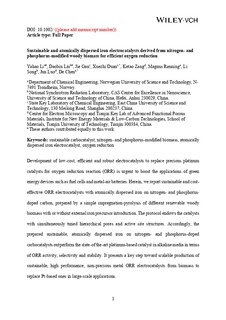| dc.contributor.author | Li, Yahao | |
| dc.contributor.author | Liu, Daobin | |
| dc.contributor.author | Gan, Jie | |
| dc.contributor.author | Duan, Xuezhi | |
| dc.contributor.author | Zang, Ketao | |
| dc.contributor.author | Rønning, Magnus | |
| dc.contributor.author | Song, Li | |
| dc.contributor.author | Luo, Jun | |
| dc.contributor.author | Chen, De | |
| dc.date.accessioned | 2020-02-05T08:16:27Z | |
| dc.date.available | 2020-02-05T08:16:27Z | |
| dc.date.created | 2020-01-19T23:19:02Z | |
| dc.date.issued | 2019 | |
| dc.identifier.citation | Advanced Materials Interfaces. 2019, 6 (4), 1801623-?. | nb_NO |
| dc.identifier.issn | 2196-7350 | |
| dc.identifier.uri | http://hdl.handle.net/11250/2639682 | |
| dc.description.abstract | Development of low‐cost, efficient, and robust electrocatalysts to replace precious platinum catalysts for oxygen reduction reaction (ORR) is urgent to boost the applications of green energy devices such as fuel cells and metal–air batteries. Herein, a low‐cost, simple, and easy‐to‐scale method to develop sustainable and cost‐effective ORR carbocatalysts via impregnation followed by pyrolysis of different renewable woody biomass is reported. Aberration‐corrected high‐angle annular dark field scanning transmission electron microscopy, X‐ray photoelectron spectroscopy, and X‐ray absorption near edge structure measurements show that the nitrogen‐ and phosphorus‐promoted atomically dispersed iron is mainly responsible for the high ORR activity. Moreover, by a mimic of the natural pine materials derived Fe‐based electrocatalyst, introducing external Fe precursor into the biomass can generate targeted well dispersed Fe complex catalysts, which is not very much dependent on the biomass types. The insights revealed here can shed new light on the development of sustainable and cost‐effective ORR carbocatalysts from biomass. | nb_NO |
| dc.language.iso | eng | nb_NO |
| dc.publisher | Wiley | nb_NO |
| dc.title | Sustainable and Atomically Dispersed Iron Electrocatalysts Derived from Nitrogen- and Phosphorus-Modified Woody Biomass for Efficient Oxygen Reduction | nb_NO |
| dc.type | Journal article | nb_NO |
| dc.type | Peer reviewed | nb_NO |
| dc.description.version | acceptedVersion | nb_NO |
| dc.source.pagenumber | 1801623-? | nb_NO |
| dc.source.volume | 6 | nb_NO |
| dc.source.journal | Advanced Materials Interfaces | nb_NO |
| dc.source.issue | 4 | nb_NO |
| dc.identifier.doi | https://doi.org/10.1002/admi.201801623 | |
| dc.identifier.cristin | 1776985 | |
| dc.description.localcode | This is the peer reviewed version of an article, which has been published in final form at [https://doi.org/10.1002/admi.201801623]. This article may be used for non-commercial purposes in accordance with Wiley Terms and Conditions for Self-Archiving. | nb_NO |
| cristin.unitcode | 194,66,30,0 | |
| cristin.unitname | Institutt for kjemisk prosessteknologi | |
| cristin.ispublished | true | |
| cristin.fulltext | postprint | |
| cristin.qualitycode | 1 | |
